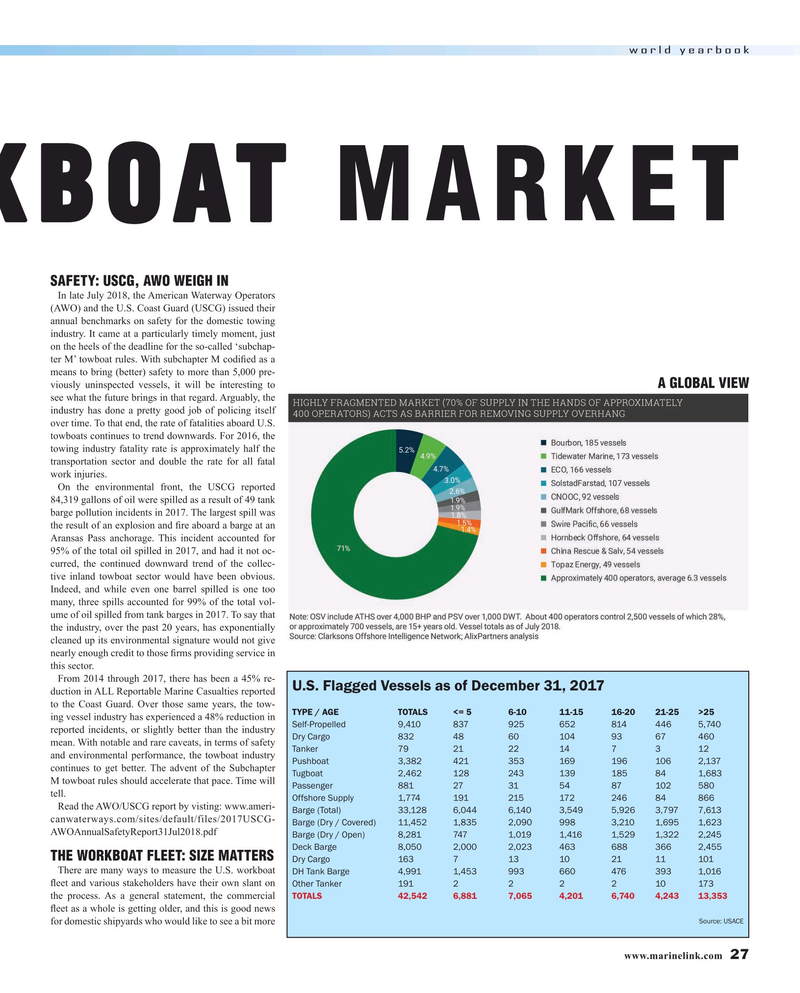
Page 27: of Maritime Reporter Magazine (June 2019)
80th Anniversary World Yearbook
Read this page in Pdf, Flash or Html5 edition of June 2019 Maritime Reporter Magazine
world yearbook
KBOAT MARKET
SAFETY: USCG, AWO WEIGH IN
In late July 2018, the American Waterway Operators (AWO) and the U.S. Coast Guard (USCG) issued their annual benchmarks on safety for the domestic towing industry. It came at a particularly timely moment, just on the heels of the deadline for the so-called ‘subchap- ter M’ towboat rules. With subchapter M codi? ed as a means to bring (better) safety to more than 5,000 pre- viously uninspected vessels, it will be interesting to
A GLOBAL VIEW see what the future brings in that regard. Arguably, the industry has done a pretty good job of policing itself over time. To that end, the rate of fatalities aboard U.S. towboats continues to trend downwards. For 2016, the towing industry fatality rate is approximately half the transportation sector and double the rate for all fatal work injuries.
On the environmental front, the USCG reported 84,319 gallons of oil were spilled as a result of 49 tank barge pollution incidents in 2017. The largest spill was the result of an explosion and ? re aboard a barge at an
Aransas Pass anchorage. This incident accounted for 95% of the total oil spilled in 2017, and had it not oc- curred, the continued downward trend of the collec- tive inland towboat sector would have been obvious.
Indeed, and while even one barrel spilled is one too many, three spills accounted for 99% of the total vol- ume of oil spilled from tank barges in 2017. To say that the industry, over the past 20 years, has exponentially cleaned up its environmental signature would not give nearly enough credit to those ? rms providing service in this sector.
From 2014 through 2017, there has been a 45% re-
U.S. Flagged Vessels as of December 31, 2017 duction in ALL Reportable Marine Casualties reported to the Coast Guard. Over those same years, the tow-
TYPE / AGE TOTALS <= 5 6-10 11-15 16-20 21-25 >25 ing vessel industry has experienced a 48% reduction in
Self-Propelled 9,410 837 925 652 814 446 5,740 reported incidents, or slightly better than the industry
Dry Cargo 832 48 60 104 93 67 460 mean. With notable and rare caveats, in terms of safety
Tanker 79 21 22 14 7 3 12 and environmental performance, the towboat industry
Pushboat 3,382 421 353 169 196 106 2,137 continues to get better. The advent of the Subchapter
Tugboat 2,462 128 243 139 185 84 1,683
M towboat rules should accelerate that pace. Time will
Passenger 881 27 31 54 87 102 580 tell.
Offshore Supply 1,774 191 215 172 246 84 866
Read the AWO/USCG report by visting: www.ameri-
Barge (Total) 33,128 6,044 6,140 3,549 5,926 3,797 7,613 canwaterways.com/sites/default/files/2017USCG-
Barge (Dry / Covered) 11,452 1,835 2,090 998 3,210 1,695 1,623
AWOAnnualSafetyReport31Jul2018.pdf
Barge (Dry / Open) 8,281 747 1,019 1,416 1,529 1,322 2,245
Deck Barge 8,050 2,000 2,023 463 688 366 2,455
THE WORKBOAT FLEET: SIZE MATTERS
Dry Cargo 163 7 13 10 21 11 101
There are many ways to measure the U.S. workboat
DH Tank Barge 4,991 1,453 993 660 476 393 1,016 ? eet and various stakeholders have their own slant on
Other Tanker 191 2 2 2 2 10 173 the process. As a general statement, the commercial
TOTALS 42,542 6,881 7,065 4,201 6,740 4,243 13,353 ? eet as a whole is getting older, and this is good news
Source: USACE for domestic shipyards who would like to see a bit more www.marinelink.com 27
MR #6 (26-33).indd 27 6/3/2019 9:50:50 AM

 26
26

 28
28
